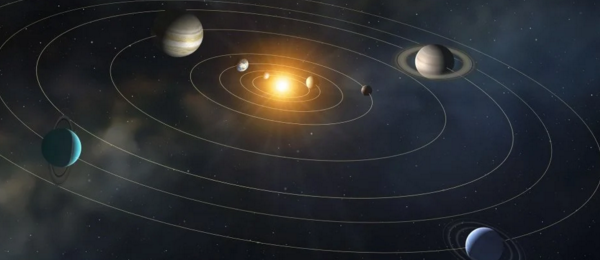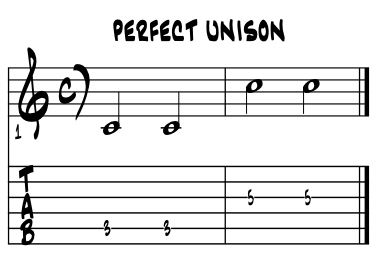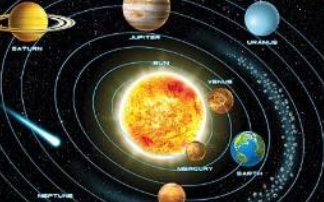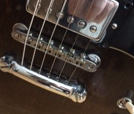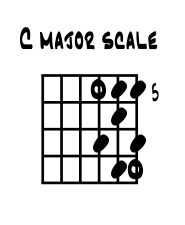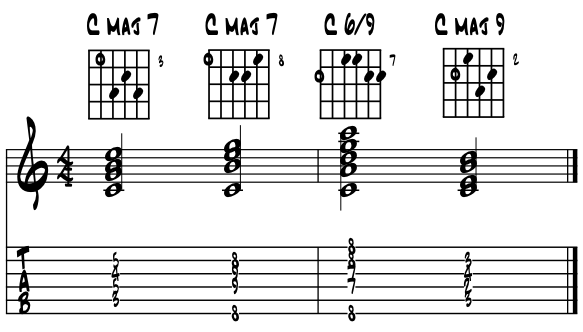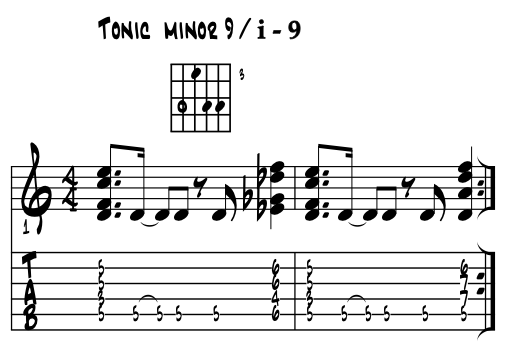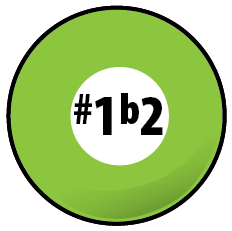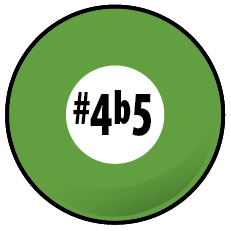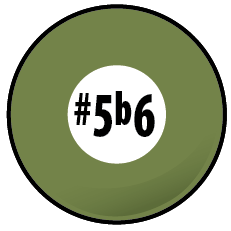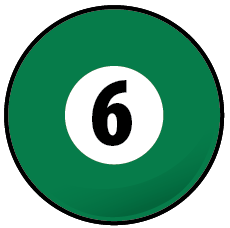~ O M m m m ... and we're home ~ ~ ONE ~ I ~ 1 ~ i ~ VIII ~ XV ~
'the root centering pitch planet orb that enables our tonal gravity to gravitate ... ... and please ... don't miss the downbeat ! :)
|
In a nutshell. 'One' is Om ... Om is 'One.' At the 'center sun' pitch in Americana songs all through it's library stacks of literature of songs is One. A kid's song in the key of 'C ?' Then ... 'C' is One. Folksy leaning towards a bluegrass a la fiddle reel in 'D ?' The letter note 'D' in pitch and symbol represents One, in every degree of the theory we discover in this song. Band leader calls a 'jazz it up' blues in 'Bb ?' Then Bb' is One, the tonic note, and it's how we letter name one of the 12 key centers. Play a modern 'chromatic blur' in 'Db ?' "Db' is One. Simple, cool and now set in stone all through the new world. |
|
For this idea of a numerical One sparks open the portal to all the theory that we use as a base to understand how the many elements of any song we love have been knit together, how the other pitches of this song will all gravitate around one pitch each with a varying degree of strength to the gravitational pull created by One in the center; all puzzled together into art moving through time becoming a statement in story to our universe. |
The following discussions explore our chosen root pitch / One for when we play songs. That it goes by a number and a number of different names, should be no surprise, maybe think of them like stylish nicknames for a popular item. Also from this point onward in our discussions, chances are there is a 7th colortone on chords. We 'add sev' and bring on the potential blue hue to our entire array of colors for creating the AmerAfroEuroLatin. |
Evolution of the artist. Understanding and accepting this theoretical idea of 'One' can become a game changer for the newly emerging theorist. For it centers a person's thinking around the one pitch in a song that unifies all the rest. From One we can measure and build it all. |
That we can apply the ideas surrounding One to all of our Americana musical styles. Thinking 'C' major, our tonic note, examine its key center letter names and corresponding numerical equivalents. Example 1. |
scale # degrees |
1 |
2 |
3 |
4 |
5 |
6 |
7 |
8 |
C major scale |
C |
D |
E |
F |
G |
A |
B |
C |
chord # / quality |
Imaj7 |
ii-7 |
iii-7 |
IVmaj7 |
V7 |
vi-7 |
vii-7 |
VIII |
diatonic 7th chords |
CEGB |
DFAC |
EGBD |
FACE |
GBDF |
ACEG |
BDFA |
CEGB |
Notice we've added a 7th to each of the triads ? Cool. |
An essential tonic scale shape. As so many of our early melodies flow to and from our tonic, having tonic centered scale shapes really helps to get the pitches under our fingers. Consider mastering this next shape if you've not already done so. Here are the pitches of the C major scale, tonic pitch to tonic pitch, in 5th position with a suggested fingering. Example 1a. |
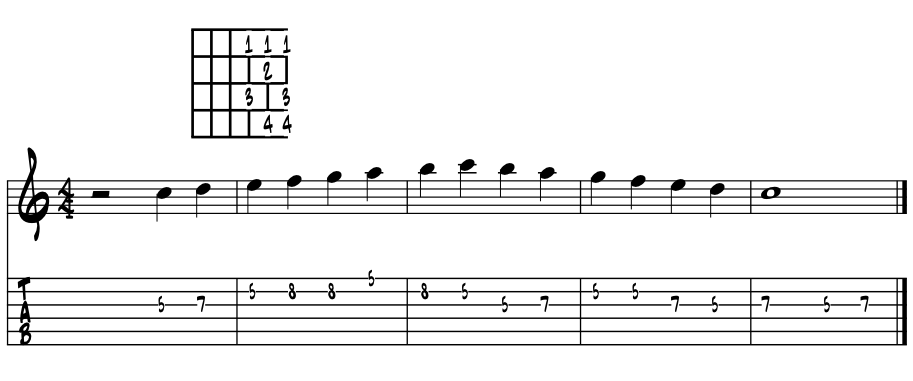 |
One to Eight and back to One. Hear the resolving sense of the pitches with the shape? For some reason it feels as if that shape has been around for us for a very long time. For this single shape can also quite easily become the center for blues guitar melodies. |
Finding One in the theory. Know the letter name of the key of the song you're playing? That letter name, or the pitch and sound it represents, we theorists know as One. The first chord in a chorus of a traditional 12 bar blues? We'll know that as a One chord. The resolving chord of our various cadential motions? A One chord. And crazy as it sounds, each of our broad categories of style can each have a distinctive harmony sound shaping for One |
Is this One like rhythm's own downbeat on one ? Pretty much, especially as the 'one' in rhythm is the first beat of a measure that we usually call the downbeat. That this One just happens to very often to get sounded on that 'one', the downbeat, is not a total coincidence. |
Becoming one with the tonic. As soon as we pick a key and launch into something, the letter name of this key becomes numerically labeled One. Also termed among theorists as the tonic pitch, it's the key that the song is written in. 'One and tonic', we use these same terms equally for both the relative minor and major keys. Common enough too in talking the blues. In everything. |
And just riffing a bit, the idea and terms 'One / tonic' are the same theory and vocabulary here in Alaska as in Seattle, LA, Austin, NYC to London and further points beyond right? Pretty much. Thus empowered, go anywhere and find your One :) Examine the following chart that spells out the 'relatives' of C and A minor, both using just the white keys of the piano. Example 1b. |
|
|
 |
Look familiar? Cool. No ? Ok just learn it here. Find some keys at some point and rote up the letter names of the keys. Run the scales up and down a few times, saying the pitch letter names with the pitches, and you'll have them forever. Fill in the rest as ya need them. Here's the rest. Example 1c. |
|
 |
Do this seven times 'end to end' and get the whole tamale. The repeating 'two / three' pattern of the black keys each locate a new octave. Example 1d. |
 |
Quick review. So just not all that complicated with the letters. Arrival at the tonic / One usually implies a resting point in the music, that deeper sense of home and center in our songs, stories and tales. Conjuring the music in between resting points is of course the other half of making the magic. The 'how we get there and back' of a well crafted musical journey. For surely getting there can be half the fun ya ... and maybe even more :) |
|
Dig the following classic Americana melody, beloved and covered by everyone who could. Acoustic guitar wizard storyteller James Taylor's rendition is especially Americana true memorable. Written here in the key of C major, this line starts and ends on One, the tonic pitch, letter named C. The words imply it was originally a banjo tune, so maybe open G. Into the wayback we go for original Americana. Example 1e. |
|
Know this melody and song? Cool. Got this line under your fingers? Check the tab or the scale shape just above for the notes if needed. Perhaps to learn it here if need be. And know that there's a way easy capture of the jaunty swing built right into Stephen Foster's classic burner "Oh Susanna." Quarter note swing built right in. |
|
While advancing cats might use more than one tonic pitch in a song, as many jazz standards feature two, even three or more key centers, most of the folk, blues, rock and pop tunes we love usually feature just one tonic pitch. When there's chords. For improvisors, this stylistic spectrum of folk to jazz creates our two core approaches to soloing; using one parent scale improvising 'over' a chord progression or, multiple parent scales while working 'through' the chord changes. Is this the 'over the river, through the trees thing ...'? Yep, sure is. |
|
Tonic symbology / capitalized / Roman #'s. Depending on how much you've been able to survey this text, you've probably figured out by now that I always try to use a capitalized letter when designating a number when it is used as a scale degree, i.e., One. This is just my way of keeping it all straight in our discussions. |
That said, we theorists have also historically used Roman numerals to describe in numerical characters the root motion of chords. Upper case numerals denote major triads while lower case traditionally denote the minor triads and extensions. This numeral designation was the standard in my theory classes at college back in the 80's. Example 1f. |
Roman numeral designations of the diatonic chords of C major |
I |
ii |
iii |
IV |
V |
vi |
vii |
VIII |
Roman numeral designations of the diatonic chords of A minor |
i |
ii |
III |
iv |
v |
VI |
VII |
viii |
Cool? Fairly straightforward it is indeed. And we can apply a sharp (#) or flat (b) for labeling the spaces in between, such as '#1' or 'bII' etc. |
Melodies. In thinking of melodies, we might say that the majority of our melodies end on the tonic pitch or One of our key center. While there's endless variations of this idea as we move through the musical styles and songs, too many essential melodies close out on the tonic pitch to not be familiar with. Do our chord progressions follow a similar scheme too? Pretty much and in popular songs, chord progressions nearly always end on One. |
Tonic / One modes / Ionian ~ Aeolian. In thinking of groups of pitches and the common major / relative minor pairing of key centers, we associate the Ionian mode with One in our major key centers and usually just call this grouping our major scale. The Aeolian mode is One in minor, its basic grouping of pitches commonly creating the natural minor scale or grouping of pitches. This pairing we know as the 'relative' major / minor. |
Streamline the theory. Further, our tonic pitch / One's tonal centering attributes are so essential in our music theory system that we theorists assign what we term a chord type to One, based on its historical prominence, harmonious nature and flexible pitch construction. |
In 'Essentials', we distinguish just three unique chord types with One being the most restful center. Evolving players often use these chord type classifications to help understand, learn and manage the vast array of chords available to the evolving artist of today. |
Where in the music. We'll find the One / tonic everywhere in all of our musical styles. For like our solar sun, our numerical One is the center of our local musical universe. It is the source of our tonal gravity and we'll measure all interval distances from our tonic pitch. So every where the sun shines in our American music, we'll usually find the tonic / One at its center. |
|
Where in history. We've just got to try and believe the idea of a tonic pitch, centering whatever pitches were available goes all the way back in time. There is that old cave bear flute that was found in Slovenia a few years back. And if that's any indication of our pitch history, then our centering on our tonic note is pretty well covered historically. |
The interval of One. The theoretical distance between two of the same pitches is termed a perfect unison. Termed perfect due to its purity of sound, and unison as the pitches are of course the same pitch. We'll see this unison in other spots in the music. Even though theoretically there is no distance or interval between the pitches, we do need a proper way to identify it by name, thus a perfect unison, One to One. Example 2. |
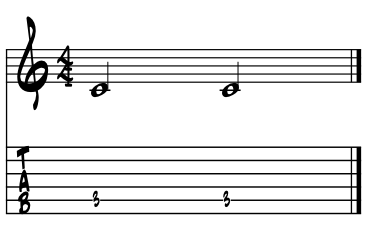 |
Key center. The first pitch of all our various groupings of pitches becomes numerically the number One. As our root or tonic pitch, our melodies and supporting harmonies usually gravitate away from, then back, to One. The beauty of our musical system of equal temper tuning allows each of the 12 pitches of the chromatic scale to fully function as One. |
Melody. This first idea is initiated with the octave interval; our purest of sounds whose interval captures the other pitches within. Surely this line will ring a bell or two :) Example 2a. |
Ya just feel the solid ground. In Americana musics and probably all world musics too, 'octave melodies' have a special place. This next hook of the classic melody, "Shortnin", while doesn't include the octave interval, has something just as deep that portrays the power of the One / tonic pitch for providing a solid and predictable start and closure of the melodic idea. We start and finish on our tonic pitch C. The vast majority of all of the AmerEuro music we love follows this tonic centered tension and resolution of tonal gravity. Example 2b. |
Four out of four. This wonderful oldtime American melody makes for a fun quote for the jazz players and those so inclined. Notice the tonic / One pitch C in all four measures of the phrase? Such tonic centered melodies are the ones we often learn first as kids, as they can be among the easiest to internalize. For those so inclined, shed this melody through the 12 major keys to further sure things up. |
Under your fingers. Have you got this melody / scale shape under your fingers? It's fairly straightforward and is built from the pitches of the major pentatonic group.
In memorizing melodies such as this one, we can learn and internalize the power of the pitches. And over time, not only create our own powerful melodies but create passionate improvisations too. |
Some powerful pitches. Dig the following line in A minor, ancient melody pitches with the power of the moderne. Find these pitches within the scale shape just above. From root pitch One to Five and back. Ex. 2c. |
'Are you going ... ?' To "Scarborough Fair." Starting off a song's lyrics with a question ... surely one way to bring in a listener. And as lovely a One to One, tonic centered melody of the minor tonality as ever came to be. One to Five, then back home to One, kind of like the blues. |
About the harmony / chords. As with melodies, our harmonies usually follow along the same lines of tonal gravity. The One chord functions most often as the beginning and end points of the music. In folk, blues and rock this is nearly always the case. Jazz players will shake things up a bit but generally follow the same basic tension and release guidelines, starting a phrase on the Two chord is fairly common but ending a song on One. |
Here is the classic One / Four / Five / One chord progression. Surely this chord progression cores most of our American harmony. A cool theory key here is that we get this essential motion for both major and minor diatonically in each key center. This diatonic resource harmonizes and creates the major minor weave of chords for most of our children's songs, folk, blues, rock, country and pop. Do examine the relative pairing of 'G' major then 'E' minor key centers using root position barre chords sounding One, Four and Five. Example 3. |
 |
Pachelbel's Canon in D just might the oldest and hippest cycle for five of these six diatonic chords. A classic winter holiday theme today, we can kibble and bits it up into probably a million tunes. Example 3a. |
|
 |
Classic 70's barre chords and Roman numerals. The last two ideas used the same barre chord shapes that we often hear on the radio everyday. In all of our musical styles, the diatonic One / Four / Five / One / motion is not only as old as the hills but so often right in the thick of it in nearly every song. For example, any song written in the twelve bar blues form is structured around this 1 4 5 way. |
We theorists will often use the Roman numerals to designate our chord progressions; major chords are upper case and lower case denote minor harmonies. Songs written in a minor key follow the same numerical Roman numeral scheme. For those reading here who go on to formal theory studies in school, good chance you'll run into these ancient symbols. Here's this chart again. |
Roman numeral designations of the diatonic chords of C major |
I |
ii |
iii |
IV |
V |
vi |
vii |
VIII |
Roman numeral designations of the diatonic chords of A minor |
i |
ii |
III |
iv |
v |
VI |
VII |
viii |
Cool? Fairly straightforward it is indeed. And we can apply a sharp (#) or flat (b) for labeling the spaces in between, such as '#1' or 'bII' etc., all along the way. |
~ stgc / super theory game changers ~ |
Chord type / One / stability. Based on the quality of triad and added 7th, so the quality of the 3rd and 7th of any 7th chord, thinking in terms of chord type is a nice leap forward for the evolving guitarist. And no surprise that the chord built on the first scale degree also creates one of three types of chords. And of the three, One is the restive point in chord progressions. In thinking of chord type, we look to categorize chords by their interval construction, then creating similar but different chordal colors through voicings and color tones, that can function in the same restive way, within a diatonic key center or similar realm. Thinking by chord type comes in handy with jazz, as tunes often modulate or change keys. And conversely, some songs will have long sections of just one chord, which can beg for using a variety of harmonic colors. In both cases chord type streamlines the thinking while building up the vocabulary of chords. |
The five shapes of jazz guitar. Traditional jazz guitar rudiments are based on five scale shapes. Thinking in standard tuning, our 'built in' keys of 'G' major 'E' minor provide a foundation for understanding and learning the cycle of the five shapes. We can get everything musical from each of the five, and they each have their own unique features that are revealed as the shedding is completed. Thinking along the lines of chord type, each shape will have its own core voicing for a One chord type. Once under the fingers, it'll blossom out by finding color tones. So with five movable shapes, giving us five core chords for each of Two, Five and One, we get 15 chords to start with, and thus the mix and match begins. That everything is movable helps too, and by adding in some 'b9' slides, we've quick moves from shape to shape, over the full range of the fingerboard. |
Chord melodies. Thinking chord type can be a big help to guitarists when creating chord melody arrangements of melodies. For we can develop a vocabulary of chord shapes that feature each of the pitches. So whatever comes along in a song, we can find a chord to present its melody notes. Over time, our initial block chord melody arrangements, built up with chords by type, come to include single note lines, octaves and bit of chords, knitting our art together into song. |
For the advanced improvisor, thinking along the lines of chord type can create and catalogue a variety of choices. These we use to create the ever elusive tension / release dynamic, by varying our degrees of tonal gravity and tonic stability. Since the One chord figures so much in our music, we'll be glad of its type for variety. Please examine the evolution of various tonic / One type functioning chord voicings, through our spectrum of musical styles. Example 4. |
 |
Quite a range of colors yes ? From inside to out ? Surely that is indeed the case. And which do you recognize ? |
In the following example we examine the interval structure and some common jazz shapes for the tonic / One chord type in C major. Example 4a. |
tonic chord type intervals |
common tonic / One chord voicings |
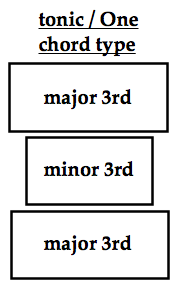 |
Major triad with a major 7th. From the building block diagram on the left, we can see that the theory core of the One chord type is the combination of a major triad and an added major 7th interval. Only the One chord type will have this foundation. |
Tonic stability. In listening to the voicings, can you sense the stability in the aural colors? They're solids, they create the restfulness within well crafted art even while retaining a degree of colortone embellishment. Pretty simple really. The trick is to decide which degree of rest and stability works for the piece and which chordal colors best express the art in your heart, at any given moment in time in the music we're creating :) |
Tonic instability / advanced diminished idea. A rather rare tonic instability can be created by using a fully diminished 7th color as a momentary One chord or tonic. Depending on the artist of course, there are varying degrees of this application of the diminished chord, scale and overall color. It is not totally uncommon to use a diminished scale color for a solo break or strike a downbeat with a tonic based on a fully diminished 7th chord prior, often just prior to the sounding of the tonic One chord. |
An evolution of tonic / One instability. Advancing artists have a couple of initial options in advancing this artistic idea. Here we begin the move from in to out of a diatonic realm. An initial trick is to simply change chord type of the written chord, while retaining the written root pitch. The dominant chord type is the color most often chosen to replace the One or Two type chords in modernizing a progression. Love that tritone! |
|
In advanced playing, these V7 chords are often altered beyond recognition and when used effectively in brighter tempos, creates music that I think I hear as a 'chromatic blur.' In this next idea we begin the de-stabilization' process by creating a delayed chord resolution via the diminished color. Example 5. |
 |
Jazz. These last ideas and concepts are in the realm of the jazz music and as such become good ways to add an 'influence' to any style. Even jazz? Sure. Lest we forget that jazz was once America's first pop music. For once tonic stability and the relationships between tension, release, balance and form are conceptualized, what 'works' open up a bit. |
Old time blues. At the historical core of American blues, it's not uncommon to hear the following tonic / One chord motion. Thinking blues in A, here we simply collapse down our dominant chord voicing to a diminished shape then return to our starting chord. Thinking blues in 'A.' Example 6. |
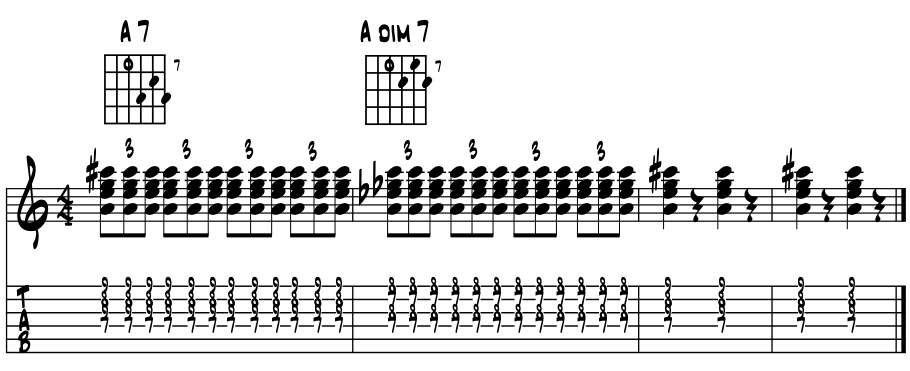 |
A classic American sound. We hear this type of sound and harmonic motion in the early blues recordings. Keyboard players lifted this of course and gradually the lick made it into the various early rock and roll sounds of the 50's and beyond. |
|
'Tonic minor 9.' Shifting to a minor tonic / One, and as deep a blue chord as minor might get, and still be pure love and devotion; the tonic minor 9.' Here's a popular guitar shape to bring this important color. Example 7. |
Review. Nice to know where our musical sun likes to hang in our local musical universe eh? Tonic stability. Predictability in the music. Tension and release. Improvisation. Building solos. Just a few of our artistic and theory considerations as we evolve in our arts. |
"Let me learn by my own mistakes." |
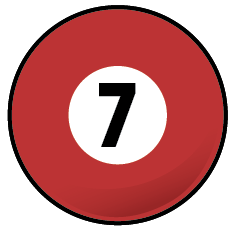 |
 |
|||||||||||
 |
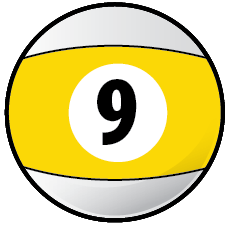 |
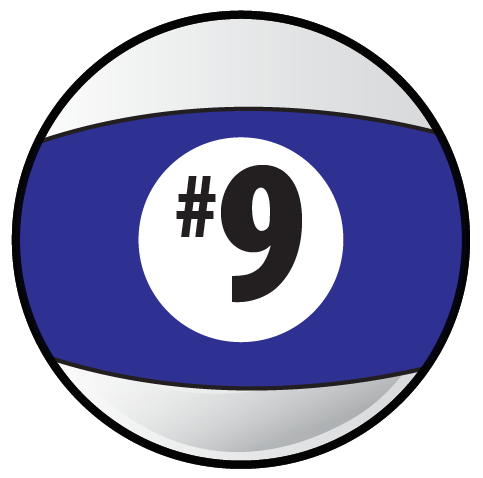 |
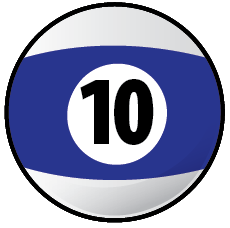 |
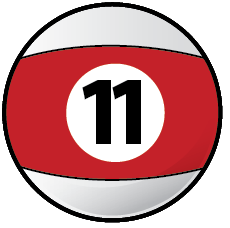 |
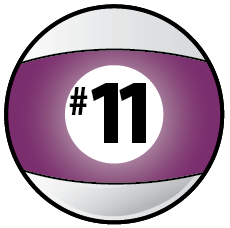 |
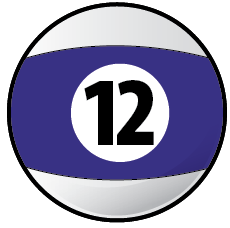 |
 |
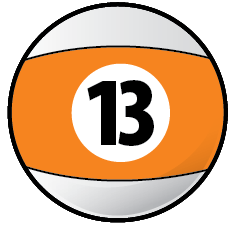 |
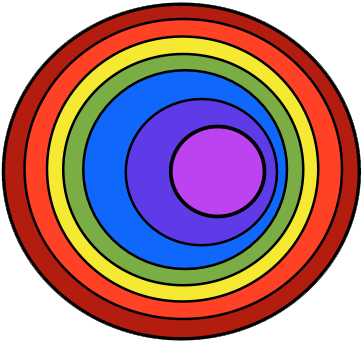 |
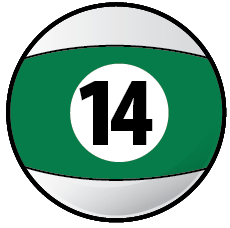 |
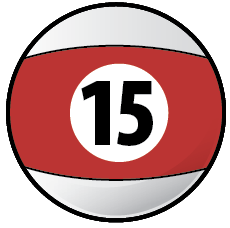 |
 |
References. References for this page's information comes from school, books and the bandstand and made way easier by the folks along the way. |
Find a mentor / e-book / academia Alaska. Always good to have a mentor when learning about things new to us. And with music and its magics, nice to have a friend or two ask questions and collaborate with. Seek and ye shall find. Local high schools, libraries, friends and family, musicians in your home town ... just ask around, someone will know someone who knows someone about music and can help you with your studies in the musical arts. |
|
Always keep in mind that all along life's journey there will be folks to help us and also folks we can help ... for we are not in this endeavor alone :) The now ancient natural truth is that we each are responsible for our own education. Positive answer this always 'to live by' question; 'who is responsible for your education ... ? |
Intensive tutoring. Luckily for musical artists like us, the learning dip of the 'covid years' can vanish quickly with intensive tutoring. For all disciplines; including all the sciences and the 'hands on' trade schools, that with tutoring, learning blossoms to 'catch us up.' In music ? The 'theory' of making musical art is built with just the 12 unique pitches, so easy to master with mentorship. And in 'practice ?' Luckily old school, the foundation that 'all responsibility for self betterment is ours alone.' Which in music, and same for all the arts, means to do what we really love to do ... to make music :) |
 |
"These books, and your capacity to understand them, are just the same in all places. Always bear in mind that your own resolution to succeed, is more important than any other one thing." |
|
Academia references of Alaska. And when you need university level answers to your questions and musings, and especially if you are considering a career in music and looking to continue your formal studies, begin to e-reach out to the Alaska University Music Campus communities and begin a dialogue with some of Alaska's finest resident maestros ! |
|
~ |
